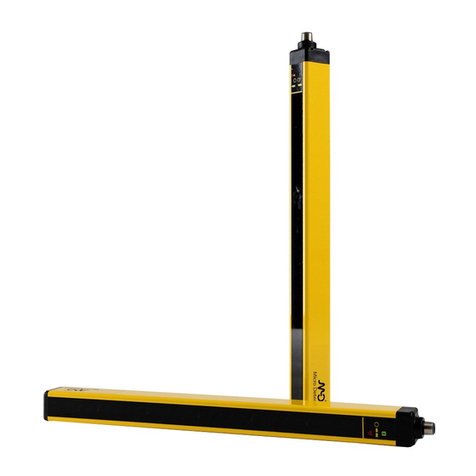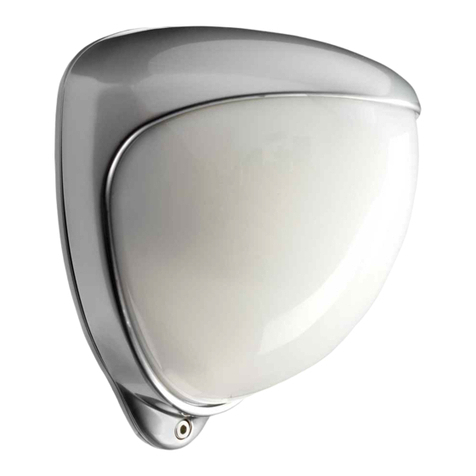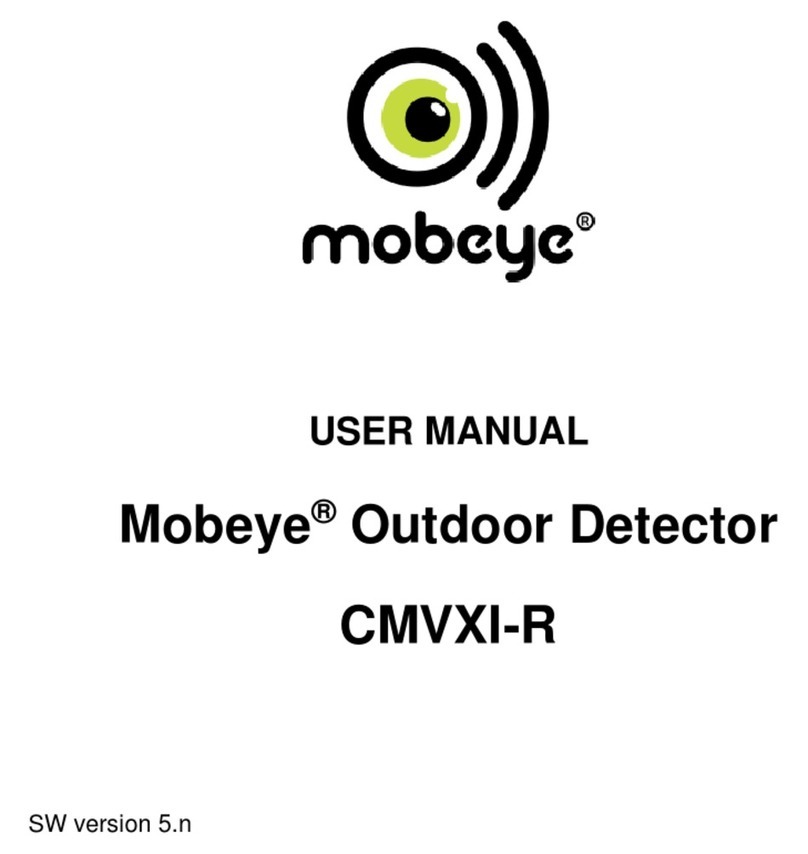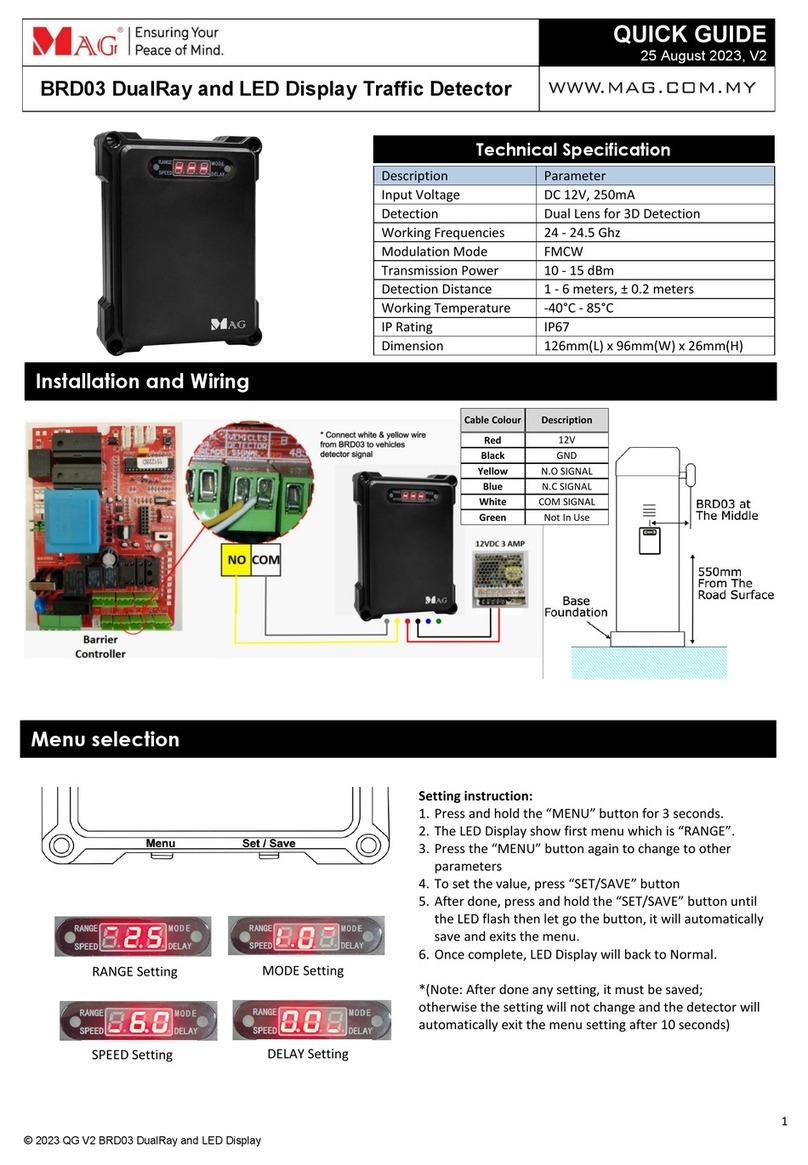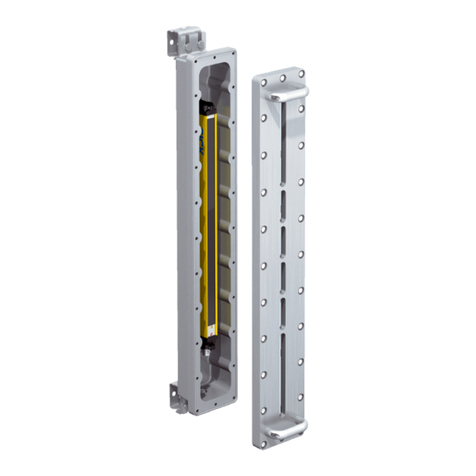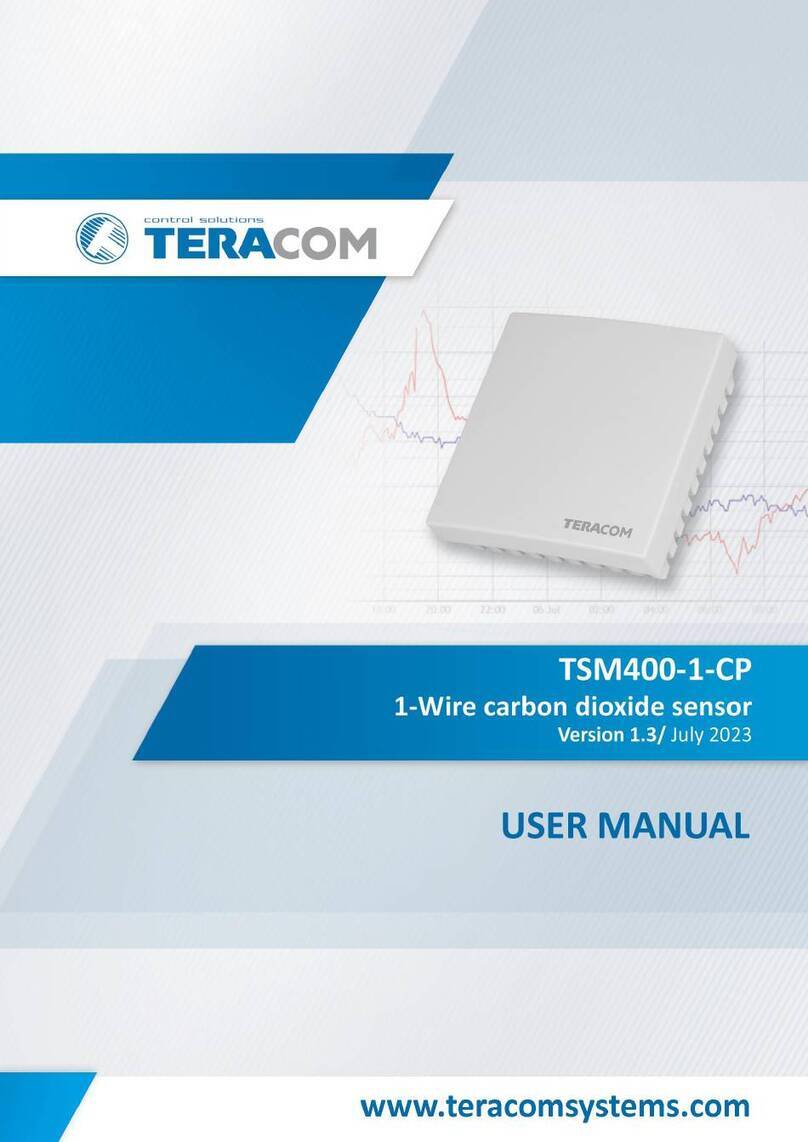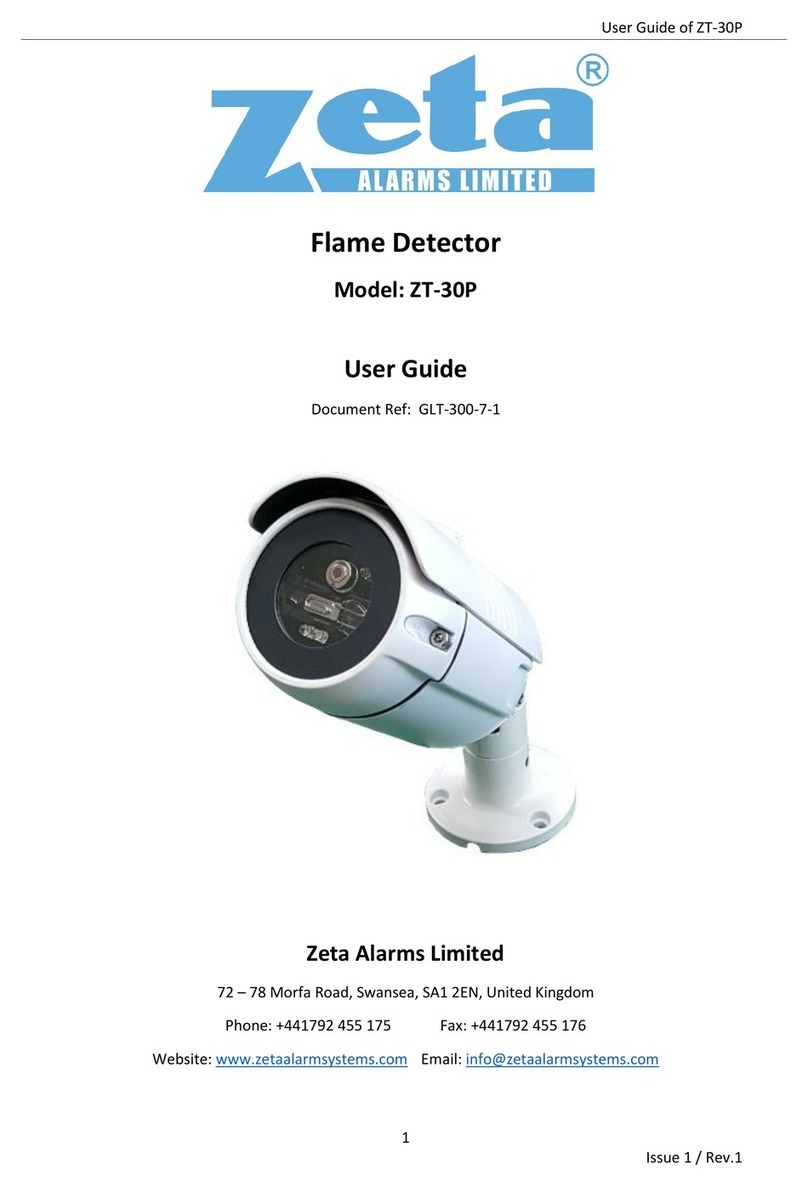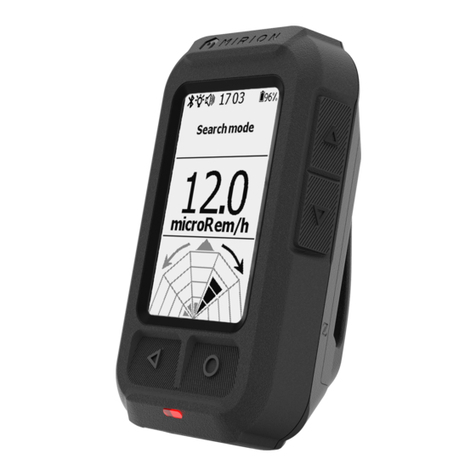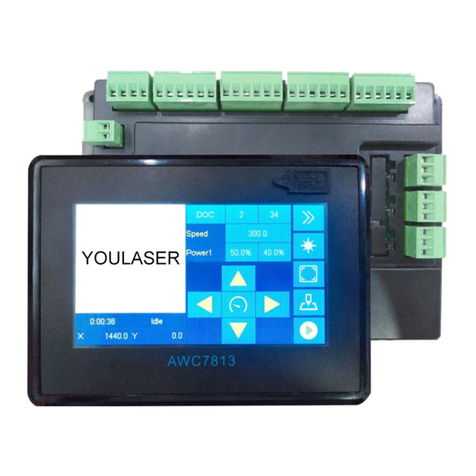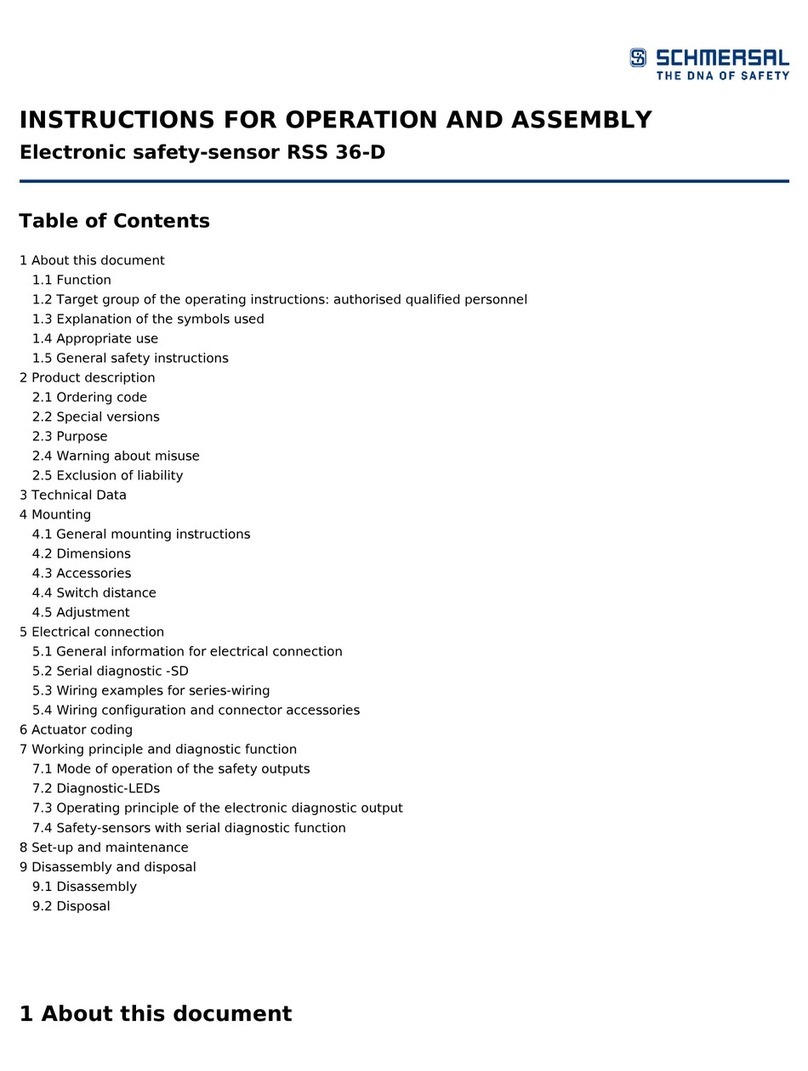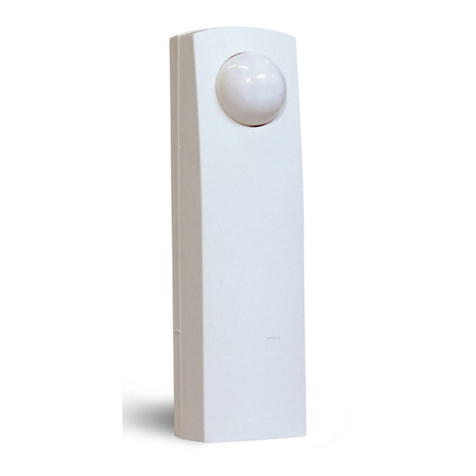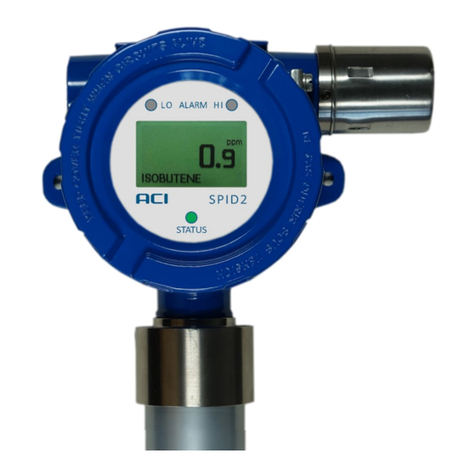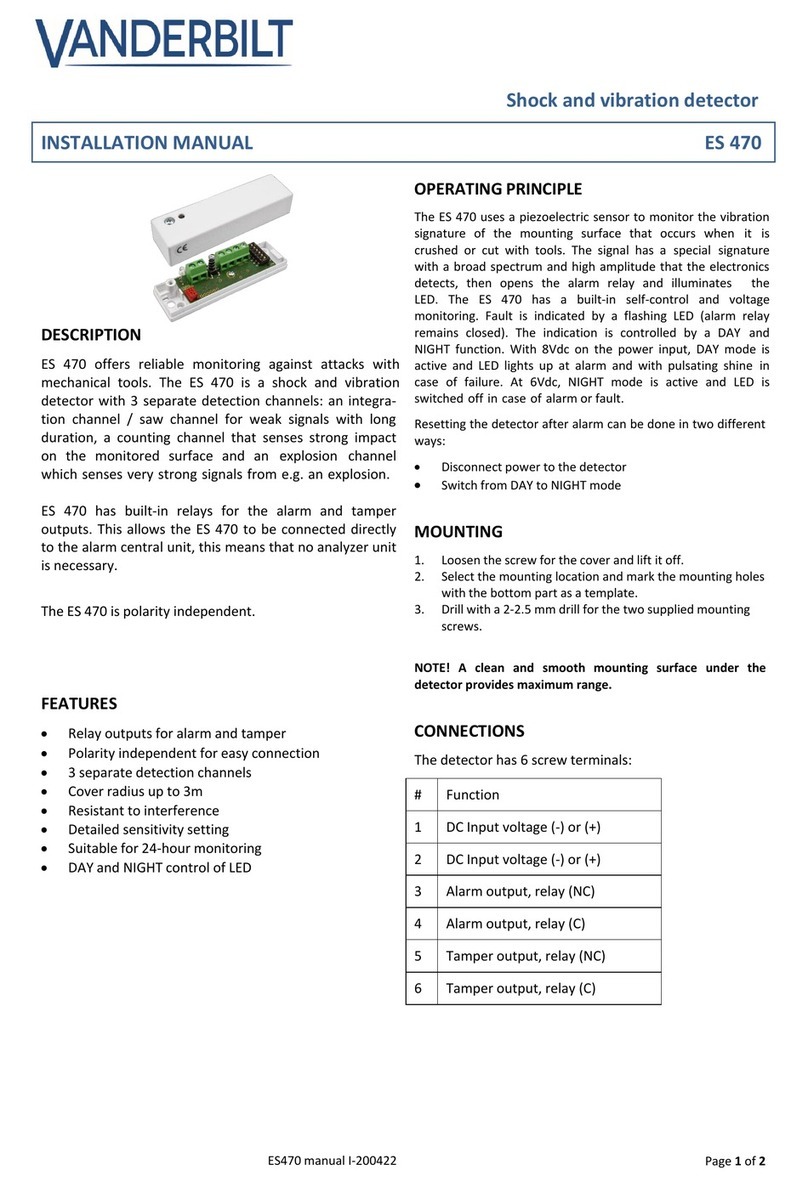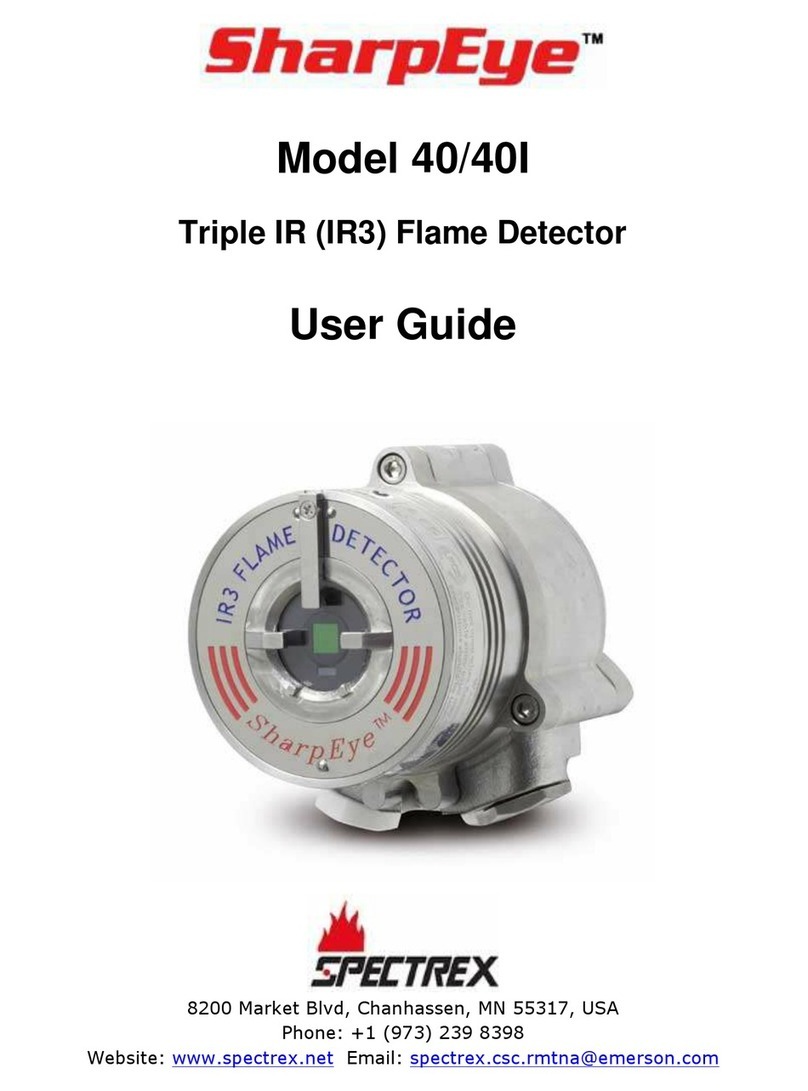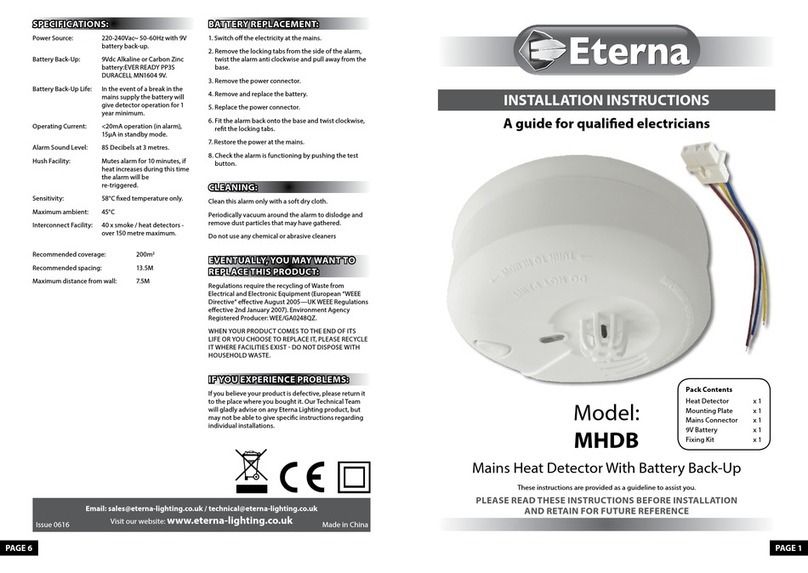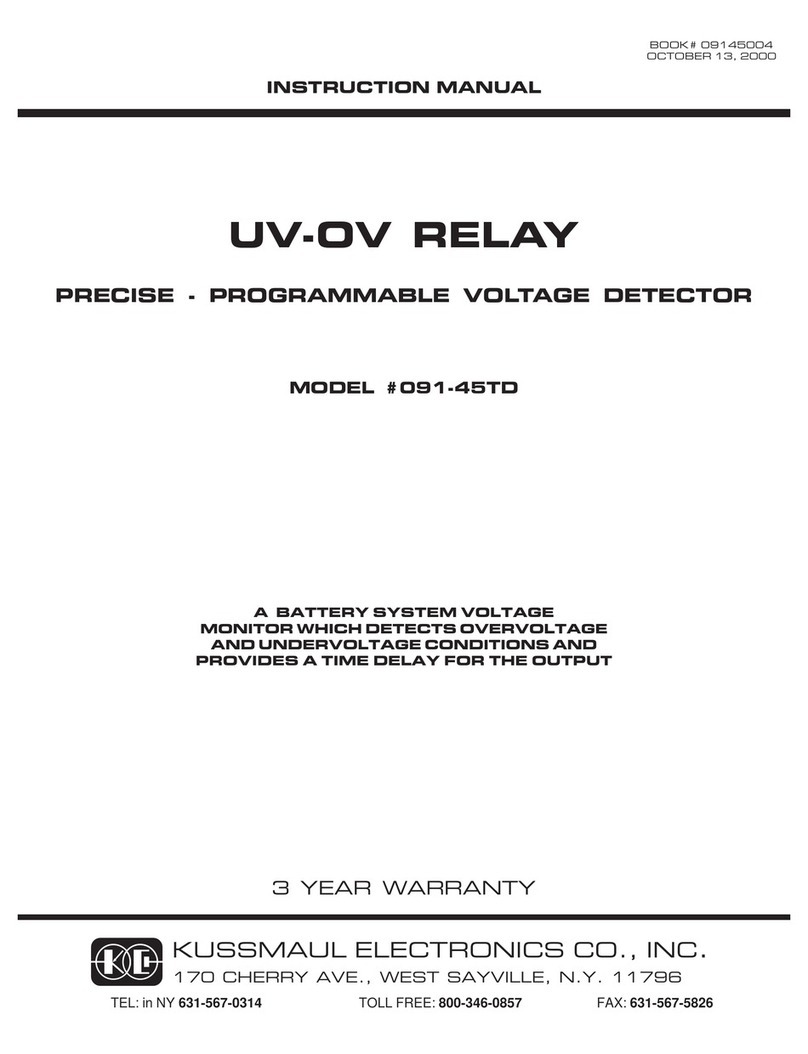Micro Detectors FC4 User manual

Datasensing S.r.l.
Strada S. Caterina 235 - 41122 Modena - Italy
Tel. +39 059 420411 - Fax +39 059 253973 -
www.datasensing.com
Declaration of conformity
Datasensing S.r.l. declares under our sole responsibility that these products are in conformity
with the EMC directive.
FC4
Installation manual - 826004760 Rev. A - ENG - Created: 25/01/2023
FOUR BEAMS FORK SENSOR
FOR BELT TRACKING
CONTROL
GENERAL DESCRIPTION
The FC4 belt tracking device consists of a fork type frame with four photocells. The device is
specially designed for use in belt tracking control with belt sanding machines. The use of two light
beams (O1and O2) gives the device a rated mechanical-optical hysteresis of 7 mm irrespective of
the colour of the sanding belt. This level of hysteresis reduces the frequency of signal switching
due to uneven belt edges.
The device provides two complementary PNP or NPN type belt tracking outputs (outputs ONC and
ONO) capable of controlling DC loads rated at 200 mA/24 V (5 W). These outputs are protected
against short circuit and overload by a self-resetting protection circuit. The logic for the ONO output
is DARK ON (i.e. signal ON when the light beam is obstructed).
Two alarm functions are provided for limit tracking conditions detected by two additional light
beams A1and A2located at a distance of 20 mm from O1and O2 respectively. The innermost alarm
light beam is positioned at 70 mm from the fork body (for further details see FIG. 1).
Either of the alarm conditions caused by A2becoming obscured or A1reading light deactivate
output A. This output consists of a 1 A, 24 V NO relay contact that is forced closed under normal
conditions. If power fails or an alarm condition occurs, the contact automatically reopens.
The belt tracking alarm condition is not held, but the device’s response times allow the contact to
remain open for at least 500 ms. This is plenty of time to safely deactivate any relays controlled by
this contact.
To verify the efciency of the relay, check that the contact remains open during device START-UP
time (0.7 s). There is no external manual adjustment for sensitivity. Sensor status is shown by
3 + 2 LEDs. See TABLE 3 and TABLE 7.
A self-test is run every time the device is powered on, and is completed within the START-UP time.
In practice, this self-test is only useful under machine set-up or repair conditions, since all the
photocells have to be free for the test to complete successfully.
At the end of device START-UP time, a self-test failure is shown by the red LED coming on (the
device’s other signals and functionalities are not affected). This LED ashes rapidly until the status
of one of the photocells changes. This makes it easy for maintenance personnel to ascertain the
status of the device. Obviously, if the red LED is showing a self-test fail, it cannot also show the
status of the alarm A output contacts.
Under normal conditions, the belt is in place when the device is powered on and therefore at least
one photocell is obscured. Under such conditions the self-test gives no signicant signal and the
red self-test fail LED will always come on momentarily.
Installation
Use the two Ø 5.5 mm holes and M5 screws to x the fork sensor in place. If the device is installed
in applications with a high level of vibration, the fork arms should also be secured. To avoid damage
to sensitive components, the device should be protected against machine malfunctions by a
metallic shield.
FIG.1
TABLE 1 – MODELS
TABLE 2 – LIGHT BEAMS
TABLE 3 – LED INDICATORS
TABLE 6 – TECHNICAL SPECIFICATIONS
TABLE 7 – DESCRIPTION OF FUNCTIONS
TABLE 4 – J1 CONNECTIONS
TABLE 5 – J2 CONNECTIONS
Light beam Description
A1Outer alarm limit
O1Outer oscillation limit
O2Inner oscillation limit
A2Inner alarm limit
LED Colour Status Description Ref.
L1 Green
OFF No external or internal power. 1
ON con with short OFF
T=3s Device powered on and device active. 2
ON Device powered on but control system
malfunction. 3
L2 Yellow
OFF
PNP (or NPN) ONO output open.
PNP (or NPN) ONC output closed.
Previous status:
beams O1and O2free
4
ON
PNP (or NPN) ONO output closed.
PNP (or NPN) ONC output open.
Previous status:
beams O1and O2obstructed
5
L3 Red
OFF Alarm relay energised, alarm not active.
Output A contacts (a1, a2) closed. 6
ON Alarm relay not energised, alarm active.
Output A contacts (a1, a2) open. 7
Flashing 3Hz
Signal only occurs on Power_ON.
Indicates that power-on self-test has failed.
No relevance to alarm relay status.
Assumes state 6 or 7 on rst change
in beam status.
8
L4 Yellow See L2 LED at end of right arm, repeats L2
signals. 9
L5 Red See L3 LED at end of left arm, repeats L3
signals. 10
PARAMETERS Minimum Typical Maximum
Sensitivity 1) 1 sheet of 80 g/m2
white paper
Wavelength 880nm
Light beam diameter (maximum obstacle diameter) 3mm
Beams aperture angle ± 15°
Oscillation hysteresis 7mm
Optical power class 1 (no danger)
Immunity to ambient light 10,000 lux, articial light
Power supply voltage 2) 3) 10VDC 24VDC 30VDC
Residual ripple 4) ≤5Vpp
Current draw 5) 30mA 70mA
Output A (alarm) 6) Electromechanical contact, 1 A, 30VDC, no short circuit protection.
Ouputs ONC and ONO (belt tracking control) Two complementary PNP (or NPN) outputs. Class DC13 (inductive load protection). Short circuit and overload protection.
Output current 200mA 300mA
Short circuit protection threshold 430mA @ 25°C
Voltage drop 2.5V@100mA
Leakage current ≤ 10 μA
Maximum capacitive load 5μF
Sampling duration 7) 4ms
Scan duration of the four beams 8) 600μs
Output ONC and ONC response times 4.7ms
Maximum output switching frequency 70Hz with 1/2 dark/light 100Hz with 1/1 dark/light
Output A contact response time 8ms (open); 500ms (close)
Time delay before availability 9) 700ms
VDE protection class III (max. voltage 50VAC), 500V insulation
Index of protection IP67
Shock resistance IEC 60068-2-27 (2008) 3axes x6, Half sine, P. acc.: 30gn, Dur.: 11ms
Vibration resistance IEC 60068-2-6 (2007) Freq.: 10…55Hz, Amp.: 0,5mm, Sweep: 5min. fr: 3x30min.
Electromagnetic compatibility Conforms to the requirements of EMC directive according to EN 60947-5-2
Operating temperature range –20 °C …+55 °C
Storage temperature range –40 °C …+75 °C
Relative humidity (non-condensing) 15 %
Weight 200g 95 %
Connections 4 pins, see TABLE 1, models, TABLE 4 and TABLE 5
Case material PC
Cable material PVC
Connector J1
Pin Colour Function Description
1 Brown 24 Vdc power input Power supply and common positive for loads
2 Yellow Belt tracking output ONC PNP or NPN NC output with short circuit protection
3 Blue 0 Vdc power input Power and output return
4 Black Belt tracking output ONO PNP or NPN NO output with short circuit protection EVENT FUNCTION DESCRIPTION
1Power_ON On power on, outputs ONO and ONC remain open and alarm output A also remains open for the duration of the “time delay before availability”.
2Self-test
A self-test is performed during the “time delay before availability”. This test terminates successfully if all the beams are free.
The green LED lights and goes off briey in 3 s cycles to signal the correct functioning of the device. This corresponds to a watchdog function.
The green LED repeats this cycle for as long as the device is powered on. A xed on green LED indicates a malfunction or power failure.
3End of
Power_ON
At the end of the “time delay before availability”, if beams O1and O2are not both obscured, output ONO is open and the yellow LED is off. Output ONC behaves in
a complementary manner. This state is maintained until event 4 or 5. If the self-test has failed, the red LED momentarily ashes in a 1/3 s cycle. This condition is
completely independent of the state of the alarm output and only persists until one of the beams changes state. The alarm output assumes the state determined by
the states of beams A1and A2(see events 6 and 7).
4
Activation
of
output ONO
(ONC= / ONO)
If both O1and O2are obscured, output ONO is closed, and the yellow LED is on. Output ONC behaves in a complementary manner.
This state is maintained until event 5.
5Deactivation of
output ONO
(ONC= / ONO)
If both O1and O2are free, output ONO is open and the yellow LED is off. Output ONC behaves in a complementary manner. This state is maintained until event 4.
6Activation
of AOUT alarm
This is the belt too far out alarm. If beam A1 is free, alarm output A is open. The activation response time for this state is ≤ 8 ms. The red LED is xed on.
The response time for exiting this state is 500 ms (open state persists for at least 500 ms).
7Activation
of AIN alarm
This is the belt too far in alarm. if A2 is obscured, alarm output A is open. The activation response time for this state is ≤ 8 ms. The red LED is xed on.
The response time for exiting this state is 500ms (open state persists for at least 500ms).
Connector J2
Pin Colour Function Description
1 Brown Not connected Can be used as input.
2 Yellow Alarm output A Pin a1 of alarm output contact
3 Blue Not connected Can be used as input.
4 Black Alarm output A Pin a2 of alarm output contact
(1) Dark state detection, valid for all beams individually.
(2) We recommend use of an external power supply to compensate for transient mains failures of up to 20 ms according to EN 60204.
(3) We recommend use an external power supply with max. 1 A short circuit protection.
(4) Must not exceed the max. or min. limits of the operating voltage range.
(5) Excluding loads; valid for entire power supply voltage range.
(6) Minimum load: 10m VDC, 0.01 mA. Mechanical life: 50x106oper. min. (at 3 Hz). Electrical life: 100 x 103oper. min. at 1 A 3 0VDC (at 0.5 Hz)
(7) Duration of two read cycles with integration.
(8) Scan interval between beams is 200 μs.
(9) Time taken, after power on, for outputs to switch from OFF to the state corresponding to the beam state.
Article code Description
FC4/V-00 Two pig-tail, male M12 connectors, 4 pins, cable length 600 mm. PNP output.
FC4/A-00 Two co-axial cables, 4 pins, cable length 2000 mm. PNP output.
FC4/V-01 Two pig-tail, male M12 connectors, 4 pins, cable length 600 mm. NPN output.
FC4/A-01 Two co-axial cables, 4 pins, cable length 2000 mm. NPN output.

Datasensing S.r.l.
Strada S. Caterina 235 - 41122 Modena - Italy
Tel. +39 059 420411 - Fax +39 059 253973 -
www.datasensing.com
FC4
Manuale d’installazione - 826004760 Rev. A - ITA - Creato il: 25/01/2023
FOTOCELLULA A FORCELLA
PER GUIDABORDO
A QUATTRO RAGGI
DESCRIZIONE GENERALE
La forcella guida-bordo FC4 consiste in un sensore fotoelettrico a forcella progettato specica-
tamente per funzionare come guidabordo sulle macchine levigatrici a nastro. Il sensore grazie
all’utilizzo per la guida di due raggi (O1e O2), possiede una isteresi meccanico-ottica nominale di
7mm, indipendentemente dal colore del nastro. Questa isteresi riduce le commutazioni dovute alle
irregolarità del bordo del nastro.
Sono implementate due uscite guida nastro tipo PNP o NPN, complementari (Uscite_ONC, ONO) in
grado di pilotare carichi in corrente continua con 200mA/24V (5W) nominali. Queste uscite sono
protette al corto circuito e al sovraccarico con un circuito autoripristinante; la logica di uscita, riferita
all’uscita ONO è DARK ON (uscita ON all’oscuramento dei due raggi).
Sono introdotte due funzioni aggiuntive di allarme rilevate da due aggiuntivi raggi A1e A2distanti
20mm rispettivamente da O1e O2. Il raggio di allarme interno dista dal corpo della forcella di 70mm
(per maggiori dettagli vedere la FIG. 1)
Le condizioni di allarme corrispondenti ad A2in buio o A1 in luce disattivano l’uscita A. Questa uscita
consiste in un contatto NA, da 1A, 24V, di relè che viene mantenuto chiuso in condizioni normali;
se manca l’alimentazione, o è presente una condizione di allarme, il contatto risulta aperto. La
condizione di allarme conseguente alla posizione del nastro non viene memorizzata, ma i tempi di
risposta scelti permettono di mantenere lo stato aperto al minimo per 500ms, questo dà un ampio
margine di tempo per permettere la sicura disattivazione di relè pilotati da questo contatto.
E’ necessario, a scopo di verica dell’efcienza del relè, controllare che il contatto sia aperto duran-
te lo STARTUP della macchina (0.7s).
Non è disponibile un regolazione manuale esterna della sensibilità.
Lo stato del sensore è indicato da 3 + 2 LED, vedi TAB. 3 e TAB. 7.
E’ implementata una funzione di test dell’ottica che si avvia ad ogni accensione del sensore ed
è eseguita entro il tempo di START-UP. Tale funzione è in pratica utilizzabile solo nelle condizioni
di set-up o riparazione della macchina, in quanto, per dare un esito positivo, richiede che tutte le
ottiche siano libere.
All’uscita dallo START-UP, l’esito di un test fallito viene indicato solo dal LED rosso (tutte le altre indi-
cazioni o funzionalità non sono inuenzate), che lampeggia velocemente no a che non avviene una
qualsiasi variazione dello stato delle ottiche. Ciò facilita la osservazione dello stato del sensore da
parte del manutentore; ovviamente se è presente questa indicazione il LED rosso non può indicare
lo stato del contatto di uscita allarme A.
In condizioni normali, alla accensione della macchina, essendo presente il nastro e quindi almeno
un raggio occupato, la funzione di test delle ottiche non è signicativa e la segnalazione di guasto
ottica del LED rosso sarà sempre momentaneamente presente.
Installazione
Per ssare la forcella utilizzare gli appositi due fori Ф5,5mm e viti M5. Se nella applicazione sono
presenti forti vibrazioni, è conveniente bloccare anche i bracci del sensore. In caso di disfunzioni
della macchina, per evitare danneggiamenti delle parti sensibili della forcella, è conveniente proteg-
gere la stessa con un’armatura metallica.
FIG.1
TAB. 1 – MODELLI
TAB. 2 – RAGGI OTTICI
TAB. 3 – LED INDICATORI
TAB. 6 – DATI TECNICI
TAB. 7 – DESCRIZIONE DELLE FUNZIONI
TAB. 4 – CONNESSIONI CON J1
TAB. 5 – CONNESSIONI CON J2
Dichiarazione di conformità
Datasensing S.r.l. dichiara sotto la propria responsabilità che questi prodotti sono conformi ai contenuti della
direttiva EMC.
Raggio ottico Descrizione della funzione
A1Limite allarme esterno
O1Limite oscillazione esterno
O2Limite oscillazione interno
A2Limite allarme interno
LED Colore Stato Descrizione Rif.
L1 Verde
OFF Tensione di alimentazione esterna o interna
assente. 1
ON con OFF breve T=3s Tensione di alimentazione presente e controllo
attivo. 2
ON Tensione di alimentazione presente, sistema di
controllo guasto. 3
L2 Giallo
OFF
Uscita PNP (o NPN) ONO aperta.
Uscita PNP (o NPN) ONC chiusa.
Ultimo stato assunto:
ottiche O1e O2libere
4
ON
Uscita PNP (o NPN) ONO chiusa.
Uscita PNP (o NPN) ONC aperta.
Ultimo stato assunto:
ottiche O1e O2occupate
5
L3 Rosso
OFF
Relè di allarme pilotato,
allarme non attivo.
Contatto uscita A (a1,a2) chiuso.
6
ON
Relè di allarme non pilotato,
allarme attivo.
Contatto uscita A (a1,a2) aperto.
7
Lampeggio 3Hz
Indicazione presente solo a seguito del
Power_ON.
Indica che il test ottico
eseguito all’accensione è fallito.
Non ha alcuna relazione con lo stato del relè
allarme.
Assumerà gli stati 6 o 7 alla
prima variazione dello stato delle ottiche.
8
L4 Giallo Vedi L2 LED posizionato all’estremo del braccio destro,
replica le indicazioni di L2. 9
L5 Rosso Vedi L3
LED posizionato all’estremo del braccio
sinistro,
replica le indicazioni di L3.
10
PARAMETRI Minimo Tipico Massimo
Sensibilità(1) 1 foglio di carta bianca 80g/m2
Lunghezza d’onda 880nm
Diametro fasci ottici (diametro massimo ostacolo) 3mm
Angolo ottico dei fasci ± 15°
Isteresi di basculamento 7mm
Classe ottica di potenza 1 (non pericolosa)
Immunità a luce ambiente 10.000 Lux articiale
Tensione di alimentazione 2) 3) 10VDC 24VDC 30VDC
Ondulazione residua 4) ≤5Vpp
Assorbimento di corrente 5) 30mA 70mA
Uscita A (allarme) 6) Contatto elettromeccanico da 1A, 30VDC, non protetto al c.c.
Uscite ONC e ONO (controllo guida-bordo) Due uscite Tipo PNP (o NPN) complementari. Categoria DC13 (protette al carico induttivo). Protette al corto e al sovraccarico
Corrente uscite 200mA 300mA
Intervento protezione al corto 430 mA @ 25°C
Caduta di tensione 2,5V@100mA
Corrente di fuga ≤ 10 μA
Carico capacitivo massimo 5μF
Periodo di campionamento 7) 4ms
Periodo di scansione delle quattro ottiche 8) 600μs
Tempo di risposta uscite ONC e ONC 4,7ms
Frequenza di commutazione massima uscita 70Hz con buio/luce 1/2 100Hz con buio/luce 1/1
Tempo di risposta contatto uscita A 8ms (apertura); 500ms (chiusura)
Ritardo alla disponibilità 9) 700ms
Classe di protezione VDE III (tensione max. 50VAC), isolamento 500V
Tipo di protezione IP67
Resistenza agli urti IEC 60068-2-27 (2008) 3axes x6, Half sine, P. acc.: 30gn, Dur.: 11ms
Resistenza vibrazioni IEC 60068-2-6 (2007) Freq.: 10…55Hz, Amp.: 0,5mm, Sweep: 5min. fr: 3x30min.
Compatibilità elettromagnetica Conforme ai requisiti della Direttiva EMC in accordo a EN 60947-5-2
Temperatura funzionamento –20 °C …+55 °C
Temperatura immagazzinamento –40 °C …+75 °C
Umidità dell’aria (senza condensa) 15 %
Peso 200g 95 %
Connessioni 4 poli, vedi TAB.1, modelli, TAB.4 e TAB.5
Materiali corpo PC
Materiali Cavi PVC
Connettore J1
Pin Colore Funzione Descrizione
1 Marrone Ingresso alimentazione 24Vdc Alimentazione e comune positivo carichi
2 Giallo Uscita guida bordo ONC Uscita PNP (o NPN) NC protetta al c.c.
3 Blu Ingresso alimentazione 0Vdc Ritorno alimentazione e uscite
4 Nero Uscita guida bordo ONO Uscita PNP (o NPN) NO protetta al c.c.
EVENTI FUNZIONI DESCRIZIONE
1Power_ON A seguito dell’applicazione dell’alimentazione, per il tempo di “Ritardo alla Disponibilità”, l’uscita ONO e l’uscita ONC rimangono aperte; l’uscita allarme A rimane aperta.
2Test ottica
Durante il tempo di “Ritardo alla Disponibilità”, viene eseguito un Test delle Ottiche, il risultato del test è positivo se tutte le ottiche sono libere.
Il LED verde , con periodo 3s, si accende e si spegne per un brevissimo istante per segnalare il corretto funzionamento del uC, Questo comportamento corrisponde
ad una funzione di watchdog. Il LED verde mantiene questo comportamento per tutto il tempo in cui il sensore rimane alimentato.
Un indicazione statica del LED indica una disfunzione o una mancanza di alimentazione.
3Uscita dal
Power_ON
Alla ne del tempo di “Ritardo alla Disponibilità”, se i raggi O1e O2non sono nello stesso stato oscurato, lo stato dell’uscita ONO è aperta e il LED giallo è spento;
L’uscita ONC si comporta in modo complementare. Tale stato permane no all’evento 4 o 5. Se il Test delle Ottiche ha dato un esito negativo, il LED rosso assume
momentaneamente uno stato lampeggiante con periodo 1/3s, questo non ha alcuna corrispondenza con lo stato dell’uscita allarme, tale stato rimane no alla prima
qualsiasi variazione dello stato di una delle ottiche. L’uscita allarme invece assume lo stato correlato con lo stato dei raggi A1e A2(vedi eventi 6 e 7).
4Attivazione
uscita ONO
(ONC= / ONO)
Nella condizione di ambedue i raggi O1e O2oscurati, lo stato dell’uscita ONO è chiuso, il LED giallo è acceso.
L’uscita ONC si comporta in modo complementare. Tale stato permane no all’evento 5.
5Disattivazione
uscita ONO
(ONC= / ONO)
Nella condizione di ambedue i raggi O1e O2liberi, lo stato dell’uscita ONO è aperto, il LED giallo è spento. L’uscita ONC si comporta in modo complementare.
Tale stato permane no all’evento 4.
6Attivazione
allarme AOUT
Allarme nastro troppo fuori. Nella condizione di raggio A1 libero l’uscita allarme A è aperta. Il tempo di risposta di attivazione di questo stato è ≤ 8ms. Il LED rosso si
accende sso. Il tempo di risposta all'uscita da questo stato è 500ms (lo stato aperto permane per almeno 500ms).
7Attivazione
allarme AIN
Allarme nastro troppo dentro. Nella condizione di raggio A2 occupato l’uscita allarme A è aperta. Il tempo di risposta di attivazione di questo stato è ≤ 8ms, Il LED
rosso si accende sso. Il tempo di risposta alla uscita da questo stato è 500ms (lo stato aperto permane per almeno 500ms).
Connettore J2
Pin Colore Funzione Descrizione
1 Marrone Non connesso Eventuale input.
2 Giallo Uscita allarme A Polo a1 del contatto uscita allarme
3 Blu Non connesso Eventuale input.
4 Nero Uscita allarme A Polo a2 del contatto uscita allarme
1) Rilevamento stato buio, valido singolarmente per tutti i raggi.
2) E’ consigliabile utilizzare un’alimentazione esterna atta a compensare una breve mancanza di rete no a 20 ms in conformità alla EN 60204.
3) E’ consigliabile utilizzare una alimentazione esterna protetta contro i corto circuiti di max. 1 A.
4) Non deve superare il limite max. o min. delle tolleranze espresse per la tensione di utilizzo.
5) Esclusi i carichi; in tutto il campo di tensione di alimentazione.
6) Minimo carico: 10mVDC, 0.01mA . Vita meccanica: 50x106 op. min. (a 3Hz). Vita elettrica: 100 x 103 oper. min. a 1A 30VDC (at 0.5Hz)
7) Durata di due cicli di lettura con integrazione.
8) L’intervallo di scansione tra le ottiche è di 200μs
9) Tempo impiegato, dopo l’accensione, dalle uscite per passare dallo stato OFF, ad uno stato congruente a quello dell’ottica.
Codice articolo Descrizione
FC4/V-00 Due connettori volanti maschio M12, 4 poli, lunghezza 600 mm. Uscite PNP.
FC4/A-00 Due cavi assiali, 4 poli, lunghezza 2000 mm. Uscite PNP.
FC4/V-01 Due connettori volanti maschio M12, 4 poli, lunghezza 600 mm. Uscite NPN.
FC4/A-01 Due cavi assiali, 4 poli, lunghezza 2000 mm. Uscite NPN.
Table of contents
Languages:
Other Micro Detectors Security Sensor manuals
